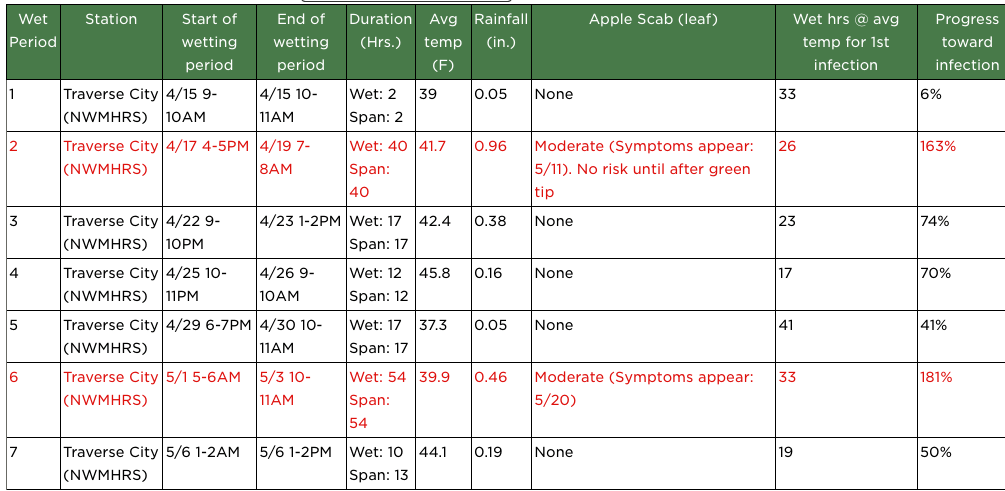Northwest Michigan fruit update – May 7, 2019
Weather conditions continue to be cool and tree development is slow. We have reached half-inch green in apples and bud burst in sweet and tart cherries.
Weather report
At the time this report was written, Michigan State University Enviroweather was experiencing issues. The website pages are either loading extremely slowly or not at all. The MSU Enviroweather team is aware of this matter and is working hard to resolve it. We will include an update in this report when the problem is fixed.
The cool and wet weather continues for spring 2019. However, we did have a bit of a reprieve over the weekend when daytime highs were in the low 60s on Saturday, May 4, and we hit 70 degrees Fahrenheit at the Northwest Michigan Horticulture Research Center on Sunday, May 5. This week’s forecast is predicting more wet and cool, and there is rain expected Wednesday and Thursday, May 8 and 9, with more clouds toward the end of the week. The first chance for sunshine is Sunday, May 12 (Mother’s Day—don’t forget!). The temperatures are predicted to remain cool here in the north, and the forecast shows highs into the mid-50s into the low 60s even next week.
Thus far, we have accumulated 152.2 growing degree days (GDD) base 42 and 56.9 GDD base 50. This is less than half of our 30-year GDD averages. We are even behind compared to 2018, which was also a cool, slow start to spring. With the current weather predictions, we will have accumulated 238 GDD base 42 by May 19, and full bloom in tart cherry is 360 GDD base 42. We still have a way to go before bloom here in the north.
Although the conditions have seemed wet/damp, we have received about 0.86-inch of rainfall since April 23. The weather has also been tricky in deciding when to apply fungicides. Despite the slow start to the 2019 season, growers should err on the conservative side and protect the green tissue (even if it is very little) against disease. If this spring is any indicator, we may have a long season ahead of us, and battling fungi for a long season may be a challenge.
|
GDD accumulations as of May 6, 2019, at the Northwest Michigan Horticulture Research Center | |||||||
|---|---|---|---|---|---|---|---|
|
Year |
2019 |
2018 |
2017 |
2016 |
2015 |
2014 |
29 Yr. Avg. |
|
GDD42 |
152.2 |
166 |
278.4 |
263.1 |
255.3 |
124.9 |
271.8 |
|
GDD50 |
56.9 |
73.4 |
111.5 |
111.5 |
107.5 |
30.2 |
117.9 |
Crop report
We have been having a hard time finding a window to prune our high-density sweet cherries. We have been hesitant to prune with these cool and wet conditions. We anticipate pruning after the rains move out Thursday, May 9. Some orchards are relatively wet with the recent rains, but with our sandy soils, most growers have had no issues in the orchard.
Honey bees have been moved into the area and are also waiting for some warm weather to do some pollinating. Planting is also underway in northwest Michigan. We have noticed new orchards in many counties. We have also noticed some blocks of tart cherries have been removed, particularly older blocks.
Pest report
As mentioned above, cold weather is continuing to have an impact on delayed development in tree fruits. While there is some green tissue present on apples, there hasn’t been much progress in terms of growth. However, we have experienced several days of wet weather and apple scab has been a concern in areas where leaves have pushed out of buds. The progress toward infection is slower in cold weather, but still possible in long wetting periods. For example, the green tip date for the Northwest Michigan Horticulture Research Center is April 22, and since then there have been five wetting events, only one of which has resulted in an infection period due to about 54 hours of wet weather at an average of 39.9 F (see figure). Most of our region experienced this long period of wet, cold weather as well as the potential for scab infections.

The forecast is calling for rains on Wednesday evening into Thursday this week. Temperatures are still cool, but warmer than they would have been in the previous May 1– 3 infection period. Hence, RIMpro models are calling for spore discharge during this upcoming wetting event and another round of possible infection periods. Leaf development in apples is variable across the region, but growers with green tissue are planning to be covered for scab prior to these rains.
Most tart cherry buds are still at side green and early bud burst, but trees on warmer sites are starting to push out little bract leaves and these bract leaves are susceptible to cherry leaf spot disease. Sweet cherry development is variable across varieties with some flower buds already showing on early varieties. We anticipate cherries will develop quickly as soon as we get warmer weather. If this happens, be ready to protect leaves from cherry leaf spot disease.



 Print
Print Email
Email
